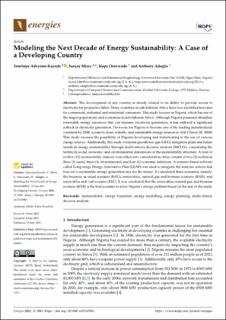| dc.description.abstract | The development of any country is closely related to its ability to provide access to electricity for productive labor. Many countries in sub-Saharan Africa have low electrification rates for commercial, industrial and residential consumers. This study focuses on Nigeria, which has one of the largest populations and economies in sub-Saharan Africa. Although Nigeria possesses abundant renewable energy resources that can increase electricity generation, it has suffered a significant setback in electricity generation. However, for Nigeria to become one of the leading industrialized countries by 2030, access to clean, reliable, and sustainable energy sources is vital (Vision 20: 2030). This study assesses the possibility of Nigeria developing and transitioning to the use of various energy sources. Additionally, this study evaluates greenhouse gas (GHG) mitigation plans and future trends in energy sustainability through multi-criteria decision analysis (MCDA), considering the technical, social, economic, and environmental dimensions of the sustainability structure. A total of twelve (12) sustainability indexes were taken into consideration; these consist of two (2) technical, three (3) social, three (3) environmental, and four (4) economic indicators. A scenario-based software called Long-range Energy Alternative Plan (LEAP) was used to integrate the analysis criteria and forecast a sustainable energy generation mix for the future. It considered three scenarios, namely: the business as usual scenario (BAU); renewables, natural gas and biomass scenario (RNB); and renewables and coal scenario (REC). It was concluded that the renewables, natural gas, and biomass scenario (RNB) is the best scenario to solve Nigeria’s energy problem based on the aim of the study. | en_US |

